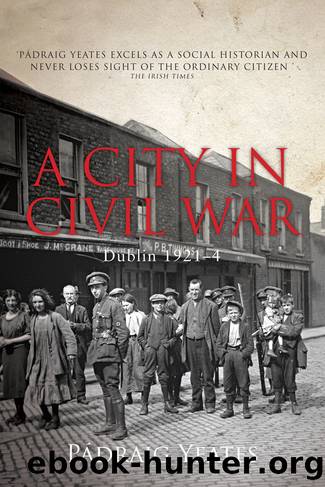A City in Civil War – Dublin 1921–1924 by Padraig Yeates

Author:Padraig Yeates
Language: eng
Format: epub
Publisher: Vearsa
preference is given in every case to men who have served with the colours. In this connection … no candidate other than ex-servicemen has been appointed to a clerkship in the Department; and approximately 70 ex-servicemen are at present employed in a temporary clerical capacity.42
There was a similar policy regarding technical staff. All six veterinary inspectors, and four technical appointees in the Fisheries Board, were ex-servicemen. All but one of the fifteen members of the crew of the Helga, which had shelled Dublin in the 1916 Rising when pressed into military service, were ex-servicemen. At the limnological laboratory on Lough Derg six of the seven employees were ex-servicemen. At Portandhu, Co. Antrim, ten of the twelve employees were ex-servicemen; the exceptions were the foreman and a carpenter. There was an identical arrangement at Knockadoon, Co. Cork, where all employees were ex-servicemen except for the foreman and carpenter. The DATI assured the government that this discriminatory recruitment policy would continue to be departmental policy.
It adopted a similar approach to maintenance and training grants. These were specifically tailored for ex-servicemen, with the aim of restoring to the labour market ‘as soon as possible the supply of men with higher general scientific, professional and business attainments whom the nation needs for every profession and industry.’ It added that ‘the scheme applies equally to officers, warrant officers, non-commissioned officers and men of like standing, who have educational qualifications [similar] to those usually possessed by officers.’ Under the scheme, academic or training fees of up to £50 a year were available, and maintenance grants of £75. A married man could receive up to £200 per year, plus £24 for each child under sixteen, up to a maximum of four. However, men over thirty were eligible only under exceptional circumstances, as it was considered that anyone who was that old and would have been eligible for entry to university or a profession would already have qualified before the war. There were also Lord Kitchener Memorial Scholarships for the sons of ex-servicemen; the department said that a lot of these had been granted but gave no numbers.
However, very few Dubliners benefited under these schemes. The vast majority of grants went to applicants from a farming background, with the area around Enniscorthy particularly favoured, for some reason. The rural bias was inevitable, given the DATI’s remit and the overwhelmingly agricultural nature of the economy, but the capital’s educational institutions did play a prominent role when it came to training. Successful candidates attended courses in the Royal College of Science, the Royal Veterinary College, the City of Dublin Technical Schools, Pembroke Technical School, the Royal Botanic Gardens and Albert Agricultural College. A fortunate few attended the Metropolitan School of Art. For those who had not attained the educational qualifications ‘usually possessed by officers’ there were courses in motor engineering at the technical school in Ringsend. In Belfast there were courses in printing and in boot and shoe repairs, while in rural areas courses were run in such subjects as
Download
This site does not store any files on its server. We only index and link to content provided by other sites. Please contact the content providers to delete copyright contents if any and email us, we'll remove relevant links or contents immediately.
| Biomathematics | Differential Equations |
| Game Theory | Graph Theory |
| Linear Programming | Probability & Statistics |
| Statistics | Stochastic Modeling |
| Vector Analysis |
Weapons of Math Destruction by Cathy O'Neil(5029)
Factfulness: Ten Reasons We're Wrong About the World – and Why Things Are Better Than You Think by Hans Rosling(4015)
Factfulness_Ten Reasons We're Wrong About the World_and Why Things Are Better Than You Think by Hans Rosling(2751)
Descartes' Error by Antonio Damasio(2728)
A Mind For Numbers: How to Excel at Math and Science (Even If You Flunked Algebra) by Barbara Oakley(2688)
TCP IP by Todd Lammle(2633)
Applied Predictive Modeling by Max Kuhn & Kjell Johnson(2474)
Fooled by Randomness: The Hidden Role of Chance in Life and in the Markets by Nassim Nicholas Taleb(2407)
The Book of Numbers by Peter Bentley(2400)
The Tyranny of Metrics by Jerry Z. Muller(2397)
The Great Unknown by Marcus du Sautoy(2180)
Once Upon an Algorithm by Martin Erwig(2142)
Easy Algebra Step-by-Step by Sandra Luna McCune(2111)
Practical Guide To Principal Component Methods in R (Multivariate Analysis Book 2) by Alboukadel Kassambara(2088)
Lady Luck by Kristen Ashley(2067)
Police Exams Prep 2018-2019 by Kaplan Test Prep(2028)
Linear Time-Invariant Systems, Behaviors and Modules by Ulrich Oberst & Martin Scheicher & Ingrid Scheicher(1980)
All Things Reconsidered by Bill Thompson III(1957)
Secrets of Creation, Volume 1: The Mystery of the Prime Numbers by Watkins Matthew(1858)
